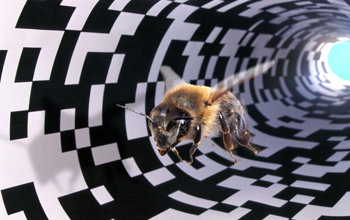Multimedia Gallery
Gene Expression Changes in Honeybees
Researchers at the University of Illinois (UI) at Urbana-Champaign found they can trick a honeybee into thinking she has travelled a longer or shorter distance through a tunnel that leads to a food source by varying the pattern on the tunnel walls. A busy pattern, such as the one pictured here, is perceived as a longer distance than a sparse pattern.
Tricking honeybees into thinking they have traveled a long distance to find food alters gene expression in their brains. The study was led by UI neuroscience and entomology professor Gene Robinson and was supported by the National Science Foundation and the Illinois Sociogenomics Initiative.
To learn more, see the UI news story Brain gene expression changes when honey bees go the distance. (Date of Image: 2000)
Credit: Photo provided by Jürgen Tautz and Marco Kleinhenz from the book "The Buzz About Bees: Biology of a Super Organism"
See other images like this on your iPhone or iPad download NSF Science Zone on the Apple App Store.
Images and other media in the National Science Foundation Multimedia Gallery are available for use in print and electronic material by NSF employees, members of the media, university staff, teachers and the general public. All media in the gallery are intended for personal, educational and nonprofit/non-commercial use only.
Images credited to the National Science Foundation, a federal agency, are in the public domain. The images were created by employees of the United States Government as part of their official duties or prepared by contractors as "works for hire" for NSF. You may freely use NSF-credited images and, at your discretion, credit NSF with a "Courtesy: National Science Foundation" notation.
Additional information about general usage can be found in Conditions.
Also Available:
Download the high-resolution JPG version of the image. (1 MB)
Use your mouse to right-click (Mac users may need to Ctrl-click) the link above and choose the option that will save the file or target to your computer.



